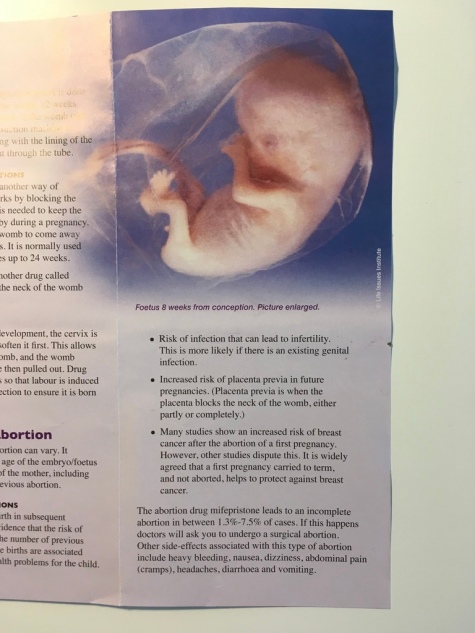A couple of weeks ago we published a story looking in to an anti-abortion campaign that had been running outside a clinic here in Fallowfield. In this article, we take a look at the two parties involved and what some of the wider arguments are.
In Fallowfield: Who is involved?
The Clinic
An organisation that provides contraception and abortion services in 37 countries. Marie Stopes International also offer several other health services including family planning and treatment of sexually transmitted diseases. They faced controversy in the UK in 2016 when the Care Quality Commission suspended some of their abortion services over concerns that proper protocols were not being followed and staff were inadequately trained.
The campaigners
40 Days for Life exists primarily in the USA but also in 28 countries worldwide. Their website proclaims that they have prevented over 12 thousand abortions and last autumn a total of 105,000 people participated in their campaigning. Although it doesn’t appear to be the case in Fallowfield, some of their groups in the UK have been criticised for using intimidating tactics such as: displaying graphic images and filming people going in to clinics.
Video: pro-life and pro-choice protesters come face to face in Ireland.
Anti-abortion campaigns and the law
In the UK, there are currently no laws against campaigning directly outside a clinic if those doing so are not stood on private property. The 40 days for Life group in Fallowfield contact the police to notify them of their presence. As they haven’t done anything that legally counts as harassment, they can stand where they do.
Proposed buffer zones
In 2014, the British Pregnancy Advice Service began to push for the introduction of buffer zones outside clinics. The back off campaign calls for legislation to prevent women facing anti-abortion groups when accessing clinics. BPAS say on their website that this would not be about ending the discussion but that:
“Women accessing pregnancy advice and abortion services are not seeking debate – they are trying to make their own personal decision about their own pregnancy.”
The arguments
Claims of links to cancer
The link between abortion and breast cancer emerged in the 1990s and is often cited by anti-abortion groups as a reason not to go through with the procedure. While certain states in the USA still require doctors by law to warn patients of a potential link, the mainstream scientific community have concluded it to be untrue. In 2012, the World Health Organisation published a journal in which they said: “Sound epidemiological data show no increased risk of breast cancer for women following spontaneous or induced abortion”.
The 40 Days for Life material states that: “Many studies show an increased risk of breast cancer after abortion of a first pregnancy. However, other studies dispute this”. The leaflet goes on to say that it is widely agreed giving birth to a child helps to reduce risk of breast cancer. Research shows that 10 years after a pregnancy, the risk drops below that of women who don’t have children, if one gives birth at a certain age.

The side-effects of abortion section of the 40 Days for Life leaflet.
When does life begin?
The big moral question at the core of the debate is the dispute over when life starts and at what point a person becomes entitled to human rights. Mr David Gazdecki, the campaigner we quoted in the first article, believes that:
“From the point of conception human rights apply.”
This belief is at the centre of the pro-life stance. Another argument to back this up comes from the harrowing process of infanticide, where an infant is killed within a year of birth. Pro-life advocates argue that the reasons supporting abortion could also apply to infanticide and that there is no way to differentiate between the two and so human rights must apply to an unborn child as well.
On the other hand, the pro-choice side argues that the difference comes from the fact that an embryo is completely reliant on the mother and the mother’s organs. While a child would require some level of care to survive once born this would not necessarily have to come from the biological mother. Therefore, the life inside a woman has no moral status until she chooses to give birth to it.
Further justification comes from the natural loss of fertilised egg. Professor Wendy Savage, a Cambridge educated gynaecologist and avid campaigner for women’s rights told us that:
“50% of fertilised ova are lost before a period is missed and another 10% in the first trimester of pregnancy so it is more usual for a fertilised egg not to become a person than to do so”
Prof. Savage also pointed out that currently a foetus is not legally considered a human being.
Video: Snippet of a 2016 interview with current American President Donald Trump.
Reflection
While writing about abortion it has been difficult to keep my own thoughts away from the page. I wanted to write something which would show a little bit of either side rather than attest to my support of abortion.
My view has not changed but I have learnt that the debate is far more alive than I perceived it to be. I thought the UK had mostly decided abortion was a sound and acceptable procedure. Instead, I discovered that it is only available in Northern Ireland under strict criteria and is classified as ‘unlawful’, while across the UK, a woman can be prosecuted for taking abortion pills herself; a law which was passed before women had the right to vote.
You could write pages upon pages for and against abortion, specifically its moral and ethical implications. It is an argument that will continue for a long time to come and one thing you can be certain of – neither side will bow down without a fight.
Have your say
